Why does laminate flooring swell?
There are many reasons for the swelling of the laminate, we will analyze the most common of them:
- Violation of the rules for styling. Firstly, you cannot start work immediately after delivery, the lamellas must lie in the room for 48-72 hours - at this time they will get used to the temperature and humidity level, and change in size. Swelling of the laminate at the joints often occurs due to insufficient expansion gap. The distance between the laminate panels and the wall should normally be 0.8-1 cm. In the event of a smaller temperature gap as a result of any change in climate or physical impact, the panels simply rest against the wall and the laminate swells. Another popular mistake is pinning boards. As the environmental conditions change, the panels expand and contract, therefore they must be installed exclusively in a floating method.
- Poor coating quality. This is the very case when the savings on the quality of the laminate will come out sideways - low-quality lamellas quickly lose their operational properties and can swell without serious reasons. Carefully inspect the product before buying: no marking, length 121.5 cm instead of 126-138 cm, dark brown "wrong side" - a sign of low-quality Chinese production.
- Installation on an unprepared base. The difference in height is no more than 1-2 mm, the absence of liquid under the floor, the absolute cleanliness of the surface (grains of sand and specks lead to squeaks). The maximum moisture content of the base is 5-12% (depending on the type); in conditions of high humidity, it is not recommended to use even high-quality panels so that they do not swell. An improperly selected or laid backing can also cause the laminate to swell. Due to a too soft or thick substrate, the locks become unusable, and the boards stand up "like a house".
- Prolonged exposure to moisture. Wet cleaning or a little spilled, but immediately wiped off liquid, a high-quality laminate will stand firmly. But as a result of a flood or a puddle that went unnoticed, the boards will become unusable and will have to be replaced.
Before talking about eliminating the swelling of the laminate, it should be noted: only a poor-quality or permanently damaged coating requires complete replacement (the laminate has become moldy, deformed). Otherwise, the laminate can be repaired.
What to do if laminate seams are swollen?
If your laminate flooring is swollen at the seams, the reasons can be different: from not leaving a gap to residual moisture. Elimination methods, respectively, will also be different.
In the photo, the seams are swollen from the water
To fix boards that have bulged due to insufficient clearance on your own:
- We dismantle the skirting boards along the entire contour.
- We mark 0.8 cm from the wall along the perimeter.
- We cut laminated boards with a laminate knife, grinder, jigsaw or other available tool.
- We align the coating, check the gap again.
- Install the skirting board in place
When the swelling is noticeable only from the front side (this happens from contact with water), it will be possible to align the edges of individual lamellas with an iron:
- Heat your iron to medium heat.
- Place a metal bar over the defect (the easiest way is to take a ruler).
- Cover the top with paper or a rag.
- Iron the area briefly with a warm iron.
Important! Too hot temperature or vigorous action can lead to damage and deformation.
For details of the correction process if the seams are swollen, see the video:
How to fix waves on laminate flooring?
The appearance of ridges is often due to an unsuitable underlay. If the laminate is swollen, you may not even look for how to fix it without disassembly. The lamellas will need to be disassembled, the dense substrate should be changed.
The photo shows a deformed laminate plank
Step by step fix process:
- Take out the furniture, remove the baseboards.
- Remove the panels one by one.
- Remove the backing.
- Lay a new, suitable one.
- Replace the flooring, skirting boards, furniture.
Tip: in order not to get confused when re-laying, mark each panel with numbers, then you can easily assemble everything a second time, like a constructor.
Maximum substrate thickness:
- 2 mm - polyethylene foam (foamed);
- 7 mm - coniferous;
- 6 mm - cork.
Important! The thinner the laminated planks, the thinner the backing should be. The optimal density values are usually indicated on the packaging - follow them and the laminate will not swell.
If the substrate is selected correctly, but the base is uneven, waves will also appear in several places. It is also impossible to fix this problem without dismantling. You will have to completely remove the laminate, the backing and fix the defects in the base.
Whether it is a cement screed or a wooden one, the surface must be leveled (maximum difference 2 mm), cleaned and dried. The maximum value of residual moisture for a concrete or self-leveling floor is 5%, for a wooden one - 10-12%.
In the photo, laying the coating on a warm floor
For laying laminated material on a warm floor, check for the presence of a special indicator on the package - not all lamellas are suitable for such a base. At the same time, after the completion of the laying work, the underfloor heating system cannot be switched on to full immediately. You need to start with a low temperature, daily raising the value by 2-3 degrees - so the laminate will gradually get used to it and will not be able to swell.
How to remove localized swelling?
Is your laminate blown up by the water? How to fix a slight unevenness without dismantling the entire floor? Let's figure it out.
When 1-2 elements are damaged, you can disassemble the covering from the nearest wall, replace the damaged panels and put everything back together. Or use another replacement option:
- Cut out the central part of the lamella, leaving 1-2 cm from the edges.
- Carefully knock out the remnants.
- Move the planks to the walls, insert a new one.
If the width is not enough, you will have to remove the locking joints from 2-3 sides. Grease the edges where the locks were removed with a suitable glue.To make repairs faster, use a drill. Details of the process in the video:
It happens that the laminate is swollen in one place due to the unevenness of the slab. Any small bump can lead to serious consequences and requires alignment. In this case, in order to return to its original appearance, it will be necessary to remove individual rows from the wall to the problem area. Level the surface and re-lay. If the locks were not damaged during operation, you will not have to change the lamellas for new ones.
What to do after the flood?
The global flood problem for your laminate flooring will reflect not only in a damaged appearance, but also in a high probability of mold formation due to water entering under the surface. That is, if it is enough to blow a small area with a hairdryer, then even a draft may not save a large area. Therefore, if the flooding was serious and the laminate was wet, it is better to disassemble all the parts and dry them properly.
In the photo, the laminate after the flood
Important! Do not take additional measures and heat the lamellas on purpose, they must dry in their natural environment. The planks are placed on their side, or stacked in piles, laying with paper and pressing on top with a load - so they will not be led or warped.
At the same time, not only the planks should dry, but also the base: pay special attention to the wood - after drying (3-15 days, depending on the scale of the disaster) it must be checked by level.
Tip: film will help in checking the quality of drying. Cover the base with it, leave it overnight. If condensation does not form on the surface, remove the film and you can lay the floor covering.
Before new laying, experts recommend replacing the substrate (especially if coniferous or cork has been laid). Polyethylene and polyurethane foam are easy enough to dry.
How to protect?
It is absolutely impossible to foresee everything. But adherence to the simple rules of prevention during laying and caring for the laminate will avoid unpleasant moments in most cases:
- Periodically treat the joints of the panels with a wax pencil, it will prevent water from getting under the top layer and the boards from getting wet.
- Do not use harsh chemicals for cleaning floors, they will damage the protective layer. The same applies to abrasive substances.
- Rub the surface of the panels with liquid wax or mastic to increase moisture resistance and improve performance.
- Thoroughly wring out the cloth when washing, wipe dry.
- Wipe up spilled liquid immediately.
- Pay attention to the label when buying - the laminate must be suitable for the conditions in which it will be used (type of base, humidity level, room temperature, underfloor heating). A dense laminate that is suitable in all respects will last for many years.
- Apply soft protective discs to the furniture legs and the bottom of the doors to avoid damaging the coating while moving. It is good to replace the wheels on the furniture with rubberized or silicone options.
- Maintain a constant humidity level between 35-65% so that the boards “walk” less.
- Do not walk on the floor in heels.
- Lift heavy furniture when carrying.
There are models of various classes, prices and quality on the market. The difference between them lies in the impregnation of the seams and the coating. For example, locks and hidden seams in waterproof laminate are often waxed. If you have purchased unprotected panels by mistake or in order to save money, you can process them yourself.
In the photo, the use of wax crayons
Waxing of joints (instead of sealant):
- Get a color pencil from a hardware store.
- Clean the surface from dust and dirt.
- Smear all joints with wax, being careful not to go beyond.
- Remove any residual material from the surface with a dry soft cloth.
Tip: wax crayons are also used to paint chips and scratches, but it is forbidden to cover the surface of the panels with them.
For shine and the formation of a light protective film over the entire surface, it is enough to add ordinary polish to the water for washing:
- Vacuum or sweep the room.
- Add polish to the water (the proportions of how much product and water are needed are written on the package).
- Clean the floor with a soft cloth along the planks.
Important! There is no need to wash off this composition!
To increase the lifespan, provide additional lasting protection and prevent premature damage to the laminate, use a special mastic:
- Thoroughly wash the floors, wait until it dries completely.
- Pour the mastic onto a soft cloth.
- Rub along the fibers, evenly distributing the composition.
Important! The laminate rubbed with mastic should not be walked on until it is completely dry.
Laminate flooring is stylish, tactile and warm, but requires special care. Follow the recommendations of the experts when buying, laying and maintaining - then the laminate will serve you for a long time.

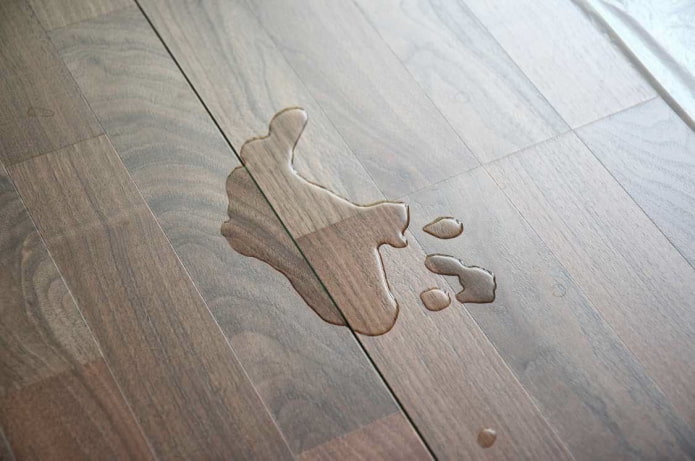
 10 practical tips for arranging a small kitchen in the country
10 practical tips for arranging a small kitchen in the country
 12 simple ideas for a small garden that will make it visually spacious
12 simple ideas for a small garden that will make it visually spacious
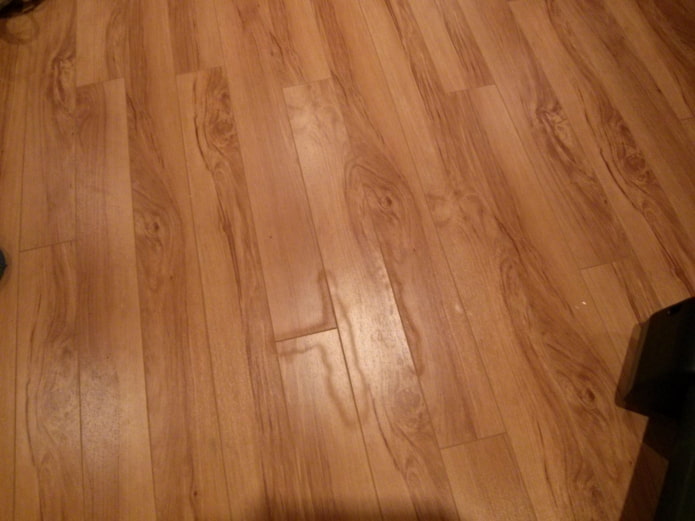

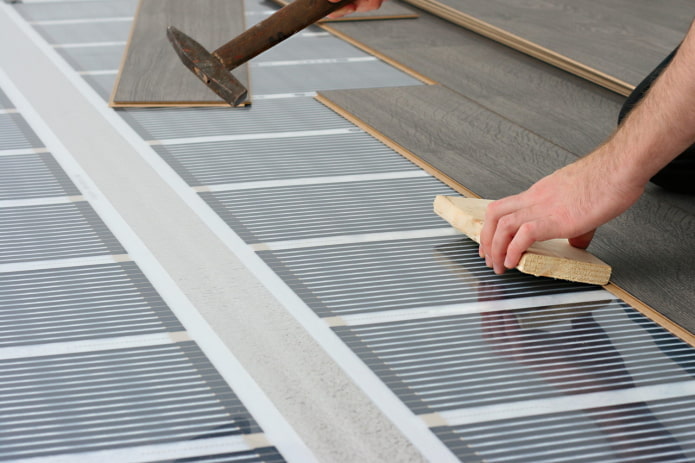

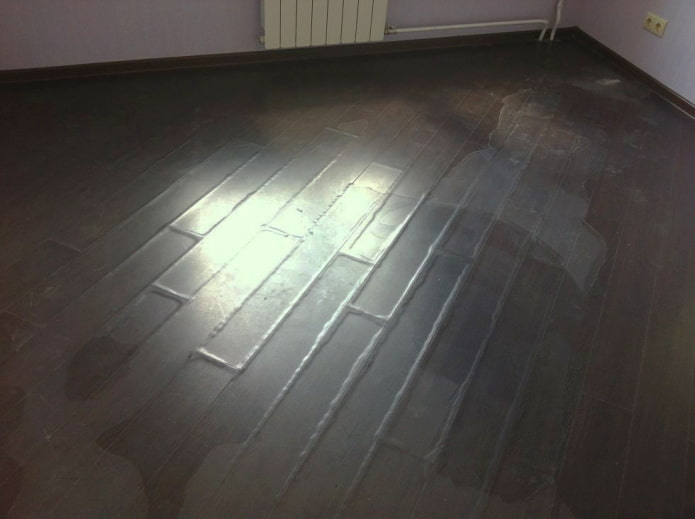


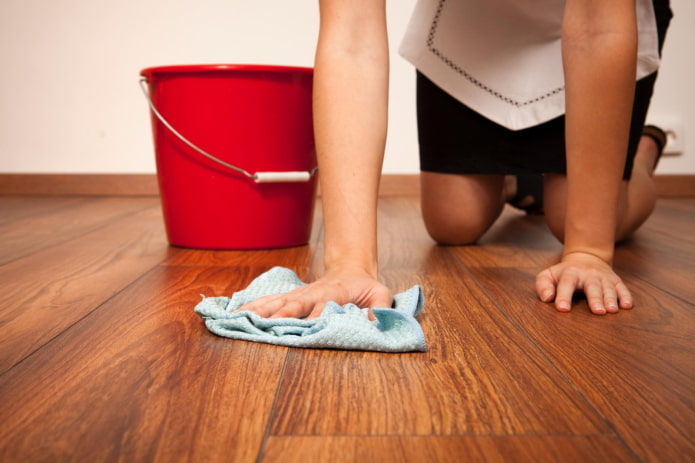
 What is better not to do it yourself during the repair?
What is better not to do it yourself during the repair? Bloated linoleum: how to fix it without disassembly
Bloated linoleum: how to fix it without disassembly The worst decisions in apartment renovation
The worst decisions in apartment renovation  Installation of ceiling tiles: choice of materials, preparation, order of work
Installation of ceiling tiles: choice of materials, preparation, order of work How to glue a ceiling plinth to a stretch ceiling?
How to glue a ceiling plinth to a stretch ceiling? Ceiling plinth for stretch ceiling: types, recommendations for selection
Ceiling plinth for stretch ceiling: types, recommendations for selection